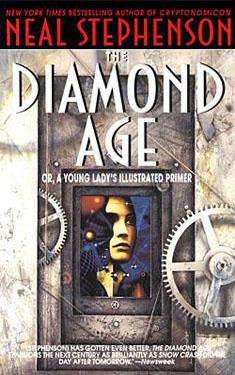Neal
Stephenson
Competed
7/8/2013, Reviewed 9/19/2013
Rating: 3 stars
 Set
in a dystopian future with a caste society of neo-Victorians, cyberpunk, and
drummers(?!),The Diamond Age introduces the idea of nanotechnology being used
to make one a more fully realized person.
It is the relationship between a young girl, an actor, and one such device,
the Young Lady’s Illustrated Primer, that makes this book a good read.
Set
in a dystopian future with a caste society of neo-Victorians, cyberpunk, and
drummers(?!),The Diamond Age introduces the idea of nanotechnology being used
to make one a more fully realized person.
It is the relationship between a young girl, an actor, and one such device,
the Young Lady’s Illustrated Primer, that makes this book a good read.
I
really liked the main character Nell. I
loved watching her develop from a child into an adult with the Primer. The Primer incorporates its user, Nell, with
her environment to create a series of learning programs and puzzles to help her
understand and get through life. What thickens
the plot is that there is also a live person, involved behind the scenes of the
Primer. Miranda is an interactive movie
actor, or ractor. She is the live voice among
the various AI characters and scenarios of the Primer. Through the Primer’s puzzles and stories,
Nell and Miranda both become obsessed about the other, without ever really
knowing for sure who each other is. The
progress of this relationship is an intense roller coaster ride as Miranda
helps guide Nell through some harrowing life experiences. I think this concept is amazing, and loved
the excitement of it.
Of
less interest to me was the pursuit of the Primer by its creator. John Hackworth never seems fully
realized. His sole dimension is that he
is a sad sack who makes a lot of bad choices.
I never empathized with him, I never really cared. This I found frustrating because his story is
the second main plotline of the book.
And
a review of this story isn’t complete without mentioning the drummers. They are a bizarre underground cult whose
primary function is to drum and have orgies.
(Uh-oh, this paragraph is going to be deleted when I submit it to the my
library’s website review database!) This
was so bizarre. It felt forced and
incongruous. It just kind of appears and
you think to yourself, “Where the heck did this come from and why is it
necessary?” It was like Stephenson was
trying to create an homage to Heinlein’s free love cult stories, but wasn’t able
to figure out how to really do it, and plopped it into the middle of this
story.
In
general, I have not enjoyed most cyberpunk stories. I often feel I lose the plotlines and
excitement because I have to muddle through the technology. However, I thought the nanotechnology here
was interesting. Perhaps it seemed a
little more organic to me. Or maybe I’ve
just read enough cyberpunk that I’d gotten a little more accustomed to or less
put off by it. Perhaps it was the more
steampunk nature of the story that made it more interesting. I think ultimately, it was the intensity of
the relationship between Nell and Miranda through the Primer that made the
nanotechnology more palatable and interesting.
Although
this book is classified as cyberpunk around the web, I felt it had more of a
steampunk feel to it, even though there was no steam. This may be due to the fact that the upper
class had a creepy neo-Victorian aesthetic.
And they used dirigibles. I therefore am coining a new genre for this
book: Victorian-nanopunk.
I
think I could have given “The Diamond Age” four stars if I could have just
cared more about Hackworth and if the drummer sequences were less
incongruous. So it ends up with three
stars. I would still highly recommend
this book as a good and interesting read.
No comments:
Post a Comment